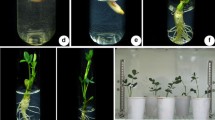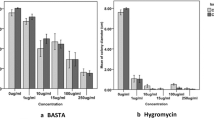Abstract
Agrobacterium tumefaciens-mediated transformation (ATMT) has been successfully applied to the violet root-rot fungus Helicobasidium mompa, which is the causal agent of violet root-rot disease. The A. tumefaciens strains carried a binary plasmid vector containing the hygromycin B phosphotransferase gene (hph) controlled by the heterologous fungal Agaricus bisporus P-gpd (glyceraldehyde-3-phosphate dehydrogenase) promoter and the trpC terminator. The transformation system was optimized using defined cocultivation conditions. When H. mompa strain V17 was cocultivated with A. tumefaciens strain AGL-1 using 5% agar, we obtained more hygromycin-resistant colonies than with strains EHA105 or MAFF301222 using 2% agar. In addition, our results suggest that the activated carbon is necessary in ATMT to reduce background growth of H. mompa. The presence of the hph gene in transformants was detected by polymerase chain reaction (PCR), and single-copy integration of the marker gene was demonstrated by Southern blot analysis. Thus, the ATMT system can be considered a promising tool for insertional mutagenesis studies of H. mompa.





Similar content being viewed by others
References
Aimi T, Iwasaki Y, Kano S, Yotsutani Y, Morinaga T (2003a) Heterologous diploid nuclei in the violet root rot fungus, Helicobasidium mompa. Mycol Res 107:1060–1068
Aimi T, Kano S, Iwasaki Y, Morinaga T (2003b) Telomeric fingerprinting of the violet root rot fungus, Helicobasidium mompa: a useful tool for karyotype estimation. Mycol Res 107:1055–1059
Bhaskaran K, Iyer SS, Khan AW, Vora VC (1974) Growth inhibition of enteric bacteria by Vibrio cholera in nutrient media containing lactate, acetate, or citrate. Antimicrob Agents Chemother 6:375–378
Bundock P, den Dulk-Ras A, Beijersbergen A, Hooykaas PJ (1995) Trans-kingdom T-DNA transfer from Agrobacterium tumefaciens to Saccharomyces cerevisiae. EMBO J 14:3206–3214
Cao Y, Niimi Y, Shang-lian HU (2006) Meropenem as an alternative antibiotic agent for suppression of Agrobacterium in genetic transformation of orchid. Agric Sci China 5:839–846
Chen X, Stone M, Schlagnhaufer C, Romaine P (2000) A fruiting body tissue method for efficient Agrobacterium-mediated transformation of Agaricus bisporus. Appl Environ Microbiol 66:4510–4513
de Groot MJ, Bundock P, Hooykaas PJ, Beijersbergen AG (1998) Agrobacterium tumefaciens- mediated homologous recombination. Nat Biotechnol 17:598–601
Fitzgerald AM, Mudge AM, Gleave AP, Plummer KM (2003) Agrobacterium and PEG-mediated transformation of the phytopathogen Venturia inaequalis. Mycol Res 107:803–810
Hanif M, Pardo AG, Gorfer M, Raudaskoski M (2002) T-DNA transfer and integration in the ectomycorrhizal fungus Suillus bovines using hygromycin B as a selectable marker. Curr Genet 41:183–188
Kilaru S, Collins CM, Hartley AJ, Bailey AM, Foster GD (2009) Establishing molecular tools for genetic manipulation of the pleuromutilin-producing fungus Clitopilus passeckerianus. Appl Environ Microbiol 75:7196–7204
Krishnamohan A, Balaji V, Veluthambi K (2001) Efficient vir gene induction in Agrobacterium tumefaciens requires virA, virG, and vir box from the same Ti plasmid. J Bacteriol 183:4079–4089
Lazo GR, Stein PA, Ludwig RA (1991) A DNA transformation-competent Arabidopsis genomic library in Agrobacterium. Biotechnology 9:963–967
Leclerque A, Wan H, Abschutz A, Chen S, Mitina GV, Zimmermann G, Achairer HU (2004) Agrobacterium-mediated insertional mutagenesis (AIM) of the entomopathogenic fungus Beauveria bassiana. Curr Genet 45:111–119
Malonek S, Meinhardt F (2001) Agrobacterium tumefaciens-mediated genetic transformation of the phytopathogenic ascomycete Calonectria morganii. Curr Genet 40:152–155
Michielse CB, Hooykaas PJJ, van den Hondel CAMJJ, Ram AFJ (2005) Agrobacterium-mediated transformation as a tool for functional genomics in fungi. Curr Genet 48:1–17
Micosh TS, Lavrijssen B, Sonnenberg AS, van Griensven LJ (2001) Transformation of the cultivated mushroom Agaricus bisporus (Lange) using T-DNA from Agrobacterium tumefaciens. Curr Genet 39:35–39
Minghua Z, Qizhou D, Lecheng L, Dahui W (2005) Activated carbon adsorption-advanced electro-oxidative regeneration for the treatment of biorefractory organic pollutants. Chin Sci Bull 50:489–491
Mozo T, Hooykaas PJJ (1991) Electroporation of megaplasmids into Agrobacterium. Plant Mol Biol 16:917–918
Ohta K, Nishiyama K (1984) Studies on the crown gall diseases of flower crops: I. Occurrence of the disease and the characterization of the causal bacterium. Ann Phytopathol Soc Jpn 50:197–204
Osaki H, Nomura K, Iwanami T, Kanematsu S, Okabe I, Matsumoto N, Sasaki A, Ohtsu Y (2002) Detection of a double-stranded RNA virus from a strain of the violet root rot fungus Helicobasidium mompa Tanaka. Virus Genes 25:139–145
Park SM, Kim DK (2004) Transformation of a filamentous fungus Cryphonectria parasitica using Agrobacterium tumefaciens. Biotechnol Bioprocess Eng 9:217–222
Piers KL, Heath JD, Liang X, Stephens KM, Nester EW (1996) Agrobacterium tumefaciens-mediated transformation of yeast. Proc Natl Acad Sci USA 93:1613–1618
Pliego C, Kanematsu S, Ruano-Rosa D, de Vicente A, López-Herrera C, Cazorla FM, Ramos C (2009) GFP sheds light on the infection process of avocado roots by Rosellinia necatrix. Fungal Genet Biol 46:137–145
Takai S (1966) Studies on helicobasidin, a pigment isolated from Helicobasidium mompa Tanaka, and its toxic action to some higher plants and microorganisms. Ringyo-Shikenjyo-Kenkyu Report 195:1–55
Wang J, Li H (2008) Agrobacterium tumefaciens-mediated genetic transformation of the phytopathogenic fungus Penicillium digitatum. J Zhejiang Univ Sci B 9:823–828
Zeilinger S (2004) Gene disruption in Trichoderma atroviride via Agrobacterium-mediated transformation. Curr Genet 45:54–60
Acknowledgments
This research was supported by the Program for Promotion of Basic and Applied Researches for Innovations in Bio-oriented Industry (BRAIN), Japan. The authors thank Dr. Hitoshi Nakamura (National Institute of Agro-Environmental Sciences, Japan) for providing the H. mompa strains and Dr. Yoshiyuki Niimi (Prefectural University of Hiroshima, Japan) for providing the Agrobacterium strain. We also thank Dr. Kiminori Shimizu (Chiba University) for providing technical advice.
Author information
Authors and Affiliations
Corresponding author
About this article
Cite this article
Kano, S., Kurita, T., Kanematsu, S. et al. Agrobacterium tumefaciens-mediated transformation of the violet root-rot fungus, Helicobasidium mompa, and the effect of activated carbon. Mycoscience 52, 24–30 (2011). https://doi.org/10.1007/s10267-010-0067-2
Received:
Accepted:
Published:
Issue Date:
DOI: https://doi.org/10.1007/s10267-010-0067-2




